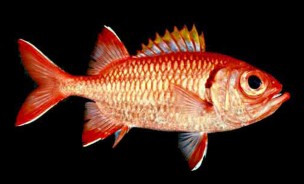Soldierfish & Squirrelfish
(Holocentridae)



Catch fish using nets, spear, hook and line, or traps. Be mindful of ciguatera toxin and check the news for a possible outbreak in the area.
Keep fish chilled in a cooler or refrigerator. Can be frozen for longer storage.
Fishes of Kaloko-Honokōhau National Historical Park


Soldierfishes and squirrelfishes belong to the Holocentridae family, which have deep bodies, large eyes and mouths, small teeth, and big coarse scales. They typically stay near caves and corals during the day but actively swim around the reef at night (Division of Aquatic and Wildlife Resources, Guam Department of Agriculture; Myers, 1999).
1. Bigscale soldierfish (Myripristis berndti)
Can be found during the day in caves or under ledges of reef flats, channels, and margins, as well as outer reef slopes. It has an orange top fin and its body is light in color.
2. Blue-lined squirrelfish (Sargocentron tiere)
Can be found hiding in holes and cracks of surge channels during the day but can be found swimming in open reef areas at night. It is known for having bright blue streaks on the sides of its body when seen in the light.
3. Long-jawed squirrelfish (Sargocentron spiniferum)
Also known as the sabre squirrelfish, it has a long venomous spine. Can be found in reef zones between the flats to lagoon and seaward reefs. During the day, it stays under ledges or in caves, but swims in reef areas at night.